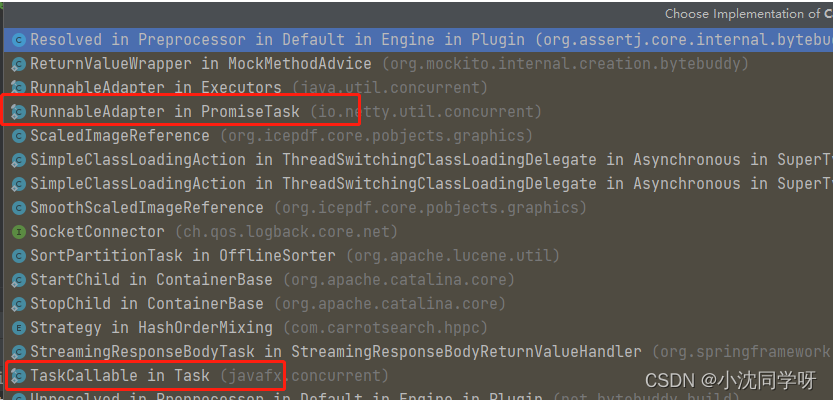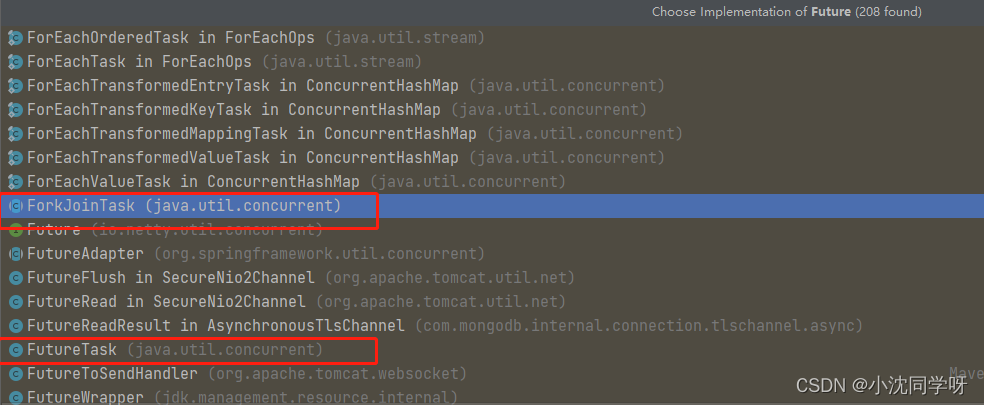前言
在多线程编程中,我们一般会根据实际业务场景来创建线程实现功能。当然创建线程的方式也有很多,比如继承Thread类、实现Runable接口或直接根据Executors类创建线程池获取线程。但是继承Thread类和实现Runable并不能获取线程执行结果,如果我们有需求要获取执行结果怎么处理呢?答案就是今天的主角——Callale与Future接口。
浅析Callale接口
Callale源码分析
进入JUC 包下找到 Callable 接口
@FunctionalInterface
public interface Callable<V> {
/**
* Computes a result, or throws an exception if unable to do so.
*
* @return computed result
* @throws Exception if unable to compute a result
*/
V call() throws Exception;
}
如上源码所示,Callable 接口内部有个call() 方法,该方法可以返回结果,如果有异常情况会抛出异常。call() 方法是 Callable 接口唯一且核心方法,我们在实际开发场景中,在call() 方法中写入具体逻辑代码并可以返回我们需要的结果。
我们继续查看 Callable 接口实现类

如图所示我们有很多工具类实现了 Callable接口,比如比较常见的 RunableAdapter、TaskCallable等等工具类,在实际业务场景我们可以任意选用我们喜欢的方式实现自己的多线程功能。
Callale简单演示
比如我们现在需要在业务场景中使用多线程执行,并且需要返回执行中的一个结果。那么,我们直接实现Callable即可:
/**
* TestCallable
* @author senfel
* @date 2023/3/20 11:06
* @return void
*/
@Test
public void TestCallable() throws Exception{
Callable<String> callable = new Callable<String>() {
@Override
public String call() throws Exception {
//具体的业务场景省略
//......
//模拟返回执行结果
return "测试1";
}
};
//获取执行结果
String call = callable.call();
//打印结果在控制台
System.err.println(call);
}
这里我们直接是简便的编码方式,当前不怕麻烦的同学可以单独写一个类实现Callable接口,然后在实例化自身的线程类并调用。
浅析Future接口
Future源码分析
上文我们讲到了实现Callable接口创建线程并获取执行接口,下面我们看看实现Future 接口方式有何异同。我们先来看源码:
package java.util.concurrent;
/**
* Future接口
*/
public interface Future<V> {
/**
* 取消
*/
boolean cancel(boolean mayInterruptIfRunning);
/**
* 获取是否取消
*/
boolean isCancelled();
/**
* 任务是否完成
*/
boolean isDone();
/**
* 循环等待执行结果
*/
V get() throws InterruptedException, ExecutionException;
/**
* 超时等待执行结果
*/
V get(long timeout, TimeUnit unit)
throws InterruptedException, ExecutionException, TimeoutException;
}
如上源码所示,我们发现 Future 接口内部提供了很多很多的操作方法。比如 cancel() 取消执行、isCancelled () 获取是否取消状态、isDone() 任务是否完成,当然还有我们最重要的 get() 获取执行结果的方法。

看到这里我们不难发现,Future 接口比 Callable接口多了很多很多的操作线程的方法。这些操作方式可以使得线程操作更加灵活,也能够让开发人员适用跟过的业务场景编码。我想说,看到Future 接口我就不想用 Callable了呢。
继续查看Futrue实现类,我们看看有哪些

如图所示,有很多的实现类。其中有大家不陌生并且经常使用到的ForkJoinTask、FutureTask,这里两个实现类应该算是在多线程开发中经常使用的吧。
我们选一个实现类进入查看Future具体的实现方式吧,我们就用 FutureTask 开探究为啥 Future要比Callable多那么多的操作方法。
进入 JUC FutureTask 查看源码
public interface RunnableFuture<V> extends Runnable, Future<V> {
/**
* Sets this Future to the result of its computation
* unless it has been cancelled.
*/
void run();
}
public class FutureTask<V> implements RunnableFuture<V> {
/*
* 执行线态
* NEW -> COMPLETING -> NORMAL
* NEW -> COMPLETING -> EXCEPTIONAL
* NEW -> CANCELLED
* NEW -> INTERRUPTING -> INTERRUPTED
*/
private volatile int state;
private static final int NEW = 0;
private static final int COMPLETING = 1;
private static final int NORMAL = 2;
private static final int EXCEPTIONAL = 3;
private static final int CANCELLED = 4;
private static final int INTERRUPTING = 5;
private static final int INTERRUPTED = 6;
/** The underlying callable; nulled out after running */
private Callable<V> callable;
/** The result to return or exception to throw from get() */
private Object outcome; // non-volatile, protected by state reads/writes
/** The thread running the callable; CASed during run() */
private volatile Thread runner;
/** Treiber stack of waiting threads */
private volatile WaitNode waiters;
/**
* Returns result or throws exception for completed task.
*
* @param s completed state value
*/
@SuppressWarnings("unchecked")
private V report(int s) throws ExecutionException {
Object x = outcome;
if (s == NORMAL)
return (V)x;
if (s >= CANCELLED)
throw new CancellationException();
throw new ExecutionException((Throwable)x);
}
/**
* Creates a {@code FutureTask} that will, upon running, execute the
* given {@code Callable}.
*
* @param callable the callable task
* @throws NullPointerException if the callable is null
*/
public FutureTask(Callable<V> callable) {
if (callable == null)
throw new NullPointerException();
this.callable = callable;
this.state = NEW; // ensure visibility of callable
}
/**
* Creates a {@code FutureTask} that will, upon running, execute the
* given {@code Runnable}, and arrange that {@code get} will return the
* given result on successful completion.
*
* @param runnable the runnable task
* @param result the result to return on successful completion. If
* you don't need a particular result, consider using
* constructions of the form:
* {@code Future<?> f = new FutureTask<Void>(runnable, null)}
* @throws NullPointerException if the runnable is null
*/
public FutureTask(Runnable runnable, V result) {
this.callable = Executors.callable(runnable, result);
this.state = NEW; // ensure visibility of callable
}
public boolean isCancelled() {
return state >= CANCELLED;
}
public boolean isDone() {
return state != NEW;
}
public boolean cancel(boolean mayInterruptIfRunning) {
if (!(state == NEW &&
UNSAFE.compareAndSwapInt(this, stateOffset, NEW,
mayInterruptIfRunning ? INTERRUPTING : CANCELLED)))
return false;
try {
// in case call to interrupt throws exception
if (mayInterruptIfRunning) {
try {
Thread t = runner;
if (t != null)
t.interrupt();
} finally {
// final state
UNSAFE.putOrderedInt(this, stateOffset, INTERRUPTED);
}
}
} finally {
finishCompletion();
}
return true;
}
}
如上源码 FutureTask 实现了 RunnableFuture 接口,RunnableFuture 又是实现了Runable和Future,所以FutureTask自然拥有了Future的功能。但是我们也看到FutureTask 构造方法需要传入实例化线程,这里可以是 Callable 实现的线程。分析到这里我们就明白了什么Future 要比 Callable多那么多的方法?原因其实就是Future是对线程操作的升华,不仅仅创建执行线程,更多的是对创建线程执行状态的维护。
Future简单演示
既然上文我们分析了FutureTask ,这里就用FutureTask 简单演示吧
/**
* TestFutureTask
* @author senfel
* @date 2023/3/20 11:34
* @return void
*/
@Test
public void TestFutureTask() throws Exception {
//实例化FutureTask,并传入一个用Callable实现的线程
FutureTask<String> task = new FutureTask<String>(new Callable<String>() {
@Override
public String call() throws Exception {
return "TestFutureTask";
}
});
//运行任务
task.run();
//获取执行结果
String s1 = task.get();
//结果打印
System.err.println(s1);
}
}
这里我们直接也是简便的编码方式,当前不怕麻烦的同学可以单独写一个类实现Callable接口,然后在实例化FutrueTask时传入。
当然,在使用Futrue过程中我们推荐线程池获取Futrue的方式
/**
* TestCallableByPool
*
* @author senfel
* @date 2023/3/20 11:43
* @return void
*/
@Test
public void TestCallableByPool() throws Exception{
//创建一个定长线程池
ExecutorService executorService = Executors.newFixedThreadPool(10);
//获取Future
Future<String> future = executorService.submit(new Callable<String>() {
@Override
public String call() throws Exception {
//具体的业务场景省略
//......
//模拟返回执行结果
return "TestCallableByPool";
}
});
String s = future.get();
System.err.println(s);
}
结语
在多线程编码需要获取线程执行结果的情况下,我们推荐使用实现Futrue 接口的方式,它比Callable方式多了很多的操作执行线程的方法,比如 cancel() 取消执行、isCancelled () 获取是否取消状态、isDone() 任务是否完成等等。在实际的开发中,我们也推荐使用多线程来创建Futrue获取执行结果。